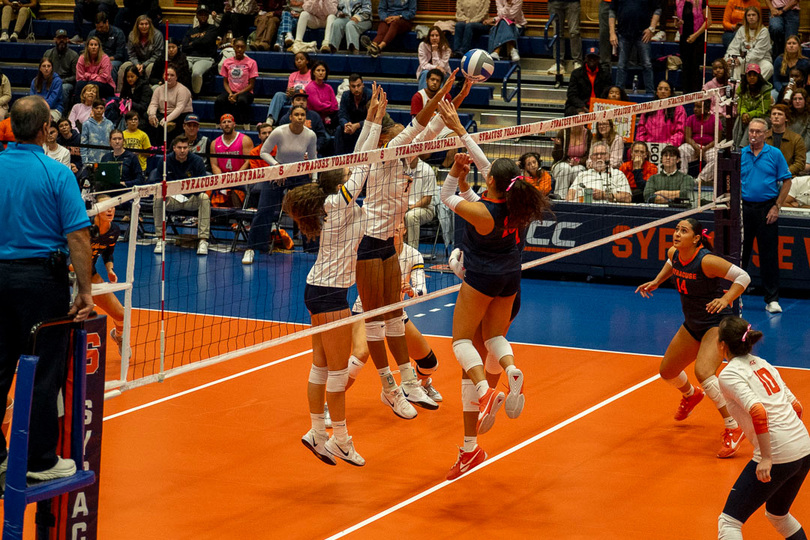3 matches, 4 takeaways: Syracuse’s ACC slump highlights 2-way fragility

SU once sat at 5-4 in ACC play, but a low hitting percentage and attacking errors led to three consecutive defeats against BC, FSU and Miami. Charlie Hynes | Staff Photographer
Get the latest Syracuse news delivered right to your inbox. Subscribe to our sports newsletter here.
Syracuse has stumbled in its last three Atlantic Coast Conference games. Holding a 5-4 ACC record, the Orange dropped three straight contests to Boston College, Florida State and Miami. In Bakeer Ganesharatnam’s fourth season at the helm, SU showed early flashes of promise, but transitioning to conference competition exposed several weaknesses.
Low hitting efficiency, high attack error rates and consistently losing the dig and block battle highlight the skid. The list goes on to describe SU’s recent downfall.
With eight ACC matchups remaining, the Orange must address those struggles to give themselves a boost in the final stretch of the season.
Here are four main takeaways from SU’s last three ACC losses:
Struggling to connect with low hitting percentage
Syracuse’s offense has struggled all season, and the numbers show it. The Orange rank 11th of 18 ACC teams with 1,058 total kills and hold a .207 team hitting percentage, the conference’s fifth-worst mark.
SU’s attackers are struggling to finish points, allowing errors to pile up. Over their last three losses to Boston College, Florida State and Miami, the Orange hit .137, .174 and .151, respectively, well below the conference average of .231..
Against BC, Gabriella McLaughlin and Skylar George combined for just 18 total kills on 75 attempts, resulting in Syracuse’s sub-.150 hitting percentage and a negative-0.03 mark in the third set alone. Facing Florida State, McLaughlin found a rhythm with 15 kills, but the rest of the team struggled to convert.
“(Success is) very rewarding, but we’re also not content or satisfied with where we are,” SU junior Sydnie Waller said after the loss to FSU.
Until the Orange can raise their efficiency, they’ll struggle to keep pace with the ACC’s best teams.

Ilyan Sarech | Design Editor
Attack errors, poor shot selection
In its last three games, Syracuse’s offense has racked up errors while its shot selection has been inconsistent, often caused by poor first touches. Through 83 sets this season, the Orange have recorded 431 attack errors, the sixth-most in the conference.
In their loss to Boston College, the Orange tallied 21 attack errors across three sets. In an earlier matchup this season against Duke, Syracuse recorded just 13 attack errors and pulled through with a 3-0 sweep, along with just four attack errors against Siena.
Individually, SU’s attackers struggled to sustain rallies, with McLaughlin, George and Marie Laurio recording just 27 kills on 94 total attempts. Syracuse also committed eight errors on 49 total attempts in the opening set, contributing to a .163 hitting percentage and allowing Boston College to win the set 25-20.
The miscues compounded against a disciplined Eagles team that converted opportunities efficiently, with BC committing only 13 total errors on 108 attempts.
Syracuse’s offensive struggles were on full display in its four-set loss to Florida State, with the Orange committing 21 attack errors.
Against Miami, the Orange had 17 attack errors. In the second set, SU hit .026, a stark contrast to Miami’s efficient offense, which recorded a .303 hitting percentage overall and converted 67 kills.
Out-dug and out-blocked
Defensively, the Orange’s front line and back‑row coverage have been outperformed. Syracuse averages just 2.14 blocks per set, placing 13th in the ACC and well below Louisville (3.03 blocks per set) and North Carolina (2.96) — the conference’s leaders.
In the back, Syracuse’s opponents are tallying 15.65 digs per set, which ranks second in the ACC. Those struggles were evident against BC. Syracuse was overpowered at the net, as Boston College totaled 12 team blocks to SU’s four on Oct. 24.
“BC has a big block, and they have been a really good blocking team for years,” Ganesharatnam said postgame. “We have undersized hitters, and it makes a big difference if you’re 6-foot-6.”
Back-row defense also contributed to the Orange’s difficulties. Despite George’s 13 digs and Rana Yamada’s 12 in the match, Syracuse allowed BC to consistently extend rallies, evident from the 232 total swings in just three sets. One week later against the Seminoles, SU’s top defenders — McLaughlin, Tehya Maeva and Yamada — combined for 32 digs, but FSU still averaged 15.75 digs per set.
Miami mirrored Florida State’s performance with Naylani Feliciano (18 digs) and Ariana Rodriguez (11 digs), keeping Syracuse from finding a consistent rhythm, which could spell disaster for SU’s playoff hopes.
Late set shortcomings
Despite coming off a five-set win, Syracuse struggled to close out sets in its match with Boston College. Early leads in the first and second sets quickly evaporated as missed opportunities helped BC regain control, ultimately leaving Syracuse on the wrong side of 25‑20 and 25‑23 sets.
SU’s matchup with Florida State again showcased the issue. In the second set, which FSU won 25-23, Syracuse once led 10-9 but fell apart late.
In their contest against Miami, the Orange and Hurricanes traded points late, and SU eventually edged out a 29-27 first-set victory. Syracuse battled back from a late deficit in the third set, too, before Miami’s Sonja Danilovic ended the frame 25-23.
Syracuse has shown it can compete in high-pressure moments, but without consistency down the stretch, its struggles may persist.






